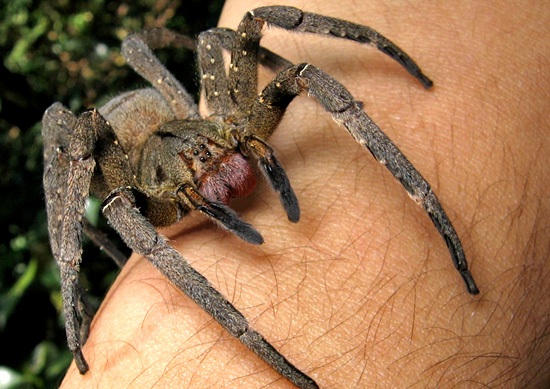The Brazilian Wandering spider, known for its potent venom, has caught the attention of scientists as a potential remedy for erectile dysfunction.
While its bite can cause severe symptoms such as pain, inflammation, and muscle control loss, the curious side effect of prolonged erections has spurred scientific curiosity for years.
To explore its therapeutic potential, researchers are launching clinical trials using a specific component of the venom known as BZ371A.
This compound is believed to enhance blood flow throughout the body, which, in nature, contributes to the spider’s deadly bite.
Isolated and tested on men and women in safety trials, BZ371A has proven to increase blood flow and facilitate erections in men when applied topically.
A Bite from the Brazilian wandering spider can cause an erection that lasts for up to four hours. pic.twitter.com/uyXuiK4ow5
— Eyan Ronaldo. 𓃵𓃵🏆 (@Timidey4you) June 28, 2022
The next trial will focus on men who have undergone prostate removal surgery due to cancer, as this group commonly experiences erectile dysfunction as a result of the procedure.
If successful, BZ371A could become a breakthrough medication for those who cannot take existing drugs for erectile dysfunction due to health conditions, which is estimated to be 33% of the male population.
“After noticing tiny spiders all over his bedroom in Brazil, …Gil Wizen looked under his bed. There, he found a venomous Brazilian wandering spider—one of the world’s most venomous spiders—guarding its brood." pic.twitter.com/AIbCXDM12l
— Lacy M. Johnson (@lacymjohnson) October 14, 2021
Professor Maria Elena de Lima, a biochemistry expert, said that the findings emphasize the importance of preserving species like the Brazilian wandering spider to unlock their potential in medicine.
The researchers also have hopes of exploring BZ371A’s potential to aid women with sexual dysfunction in the future.
Erectile dysfunction affects many men, especially those over 40, with various causes such as stress, fatigue, excessive alcohol consumption, or medication side effects.
What Are The Brazilian Wandering Spider’s Characteristics
The leg span of the Brazilian wandering spider can reach up to 4 – 5 inches. Known for their large, hairy appearance and eight eyes (two of which are large), these spiders are fast-moving with strong, spiny legs. When angered, they display distinctive red jaws.
It is important to note that the Brazilian wandering spider is not a Tarantula and belongs to a different family group.
Unlike Tarantulas, which are harmless to humans and mainly ambush prey, Brazilian wandering spiders are active hunters.
What Is It Like To Be Bitten By The Brazilian Wandering Spider?
Bites from the Brazilian Wandering spider could range from painful pinpricks to severe envenomation.
In 2007, the Brazilian Wandering spider was named the most venomous animal by Guinness Book of World Records.
The species of the Brazilian Wandering spider, Phoneutria fera and Phoneutria nigriventer, are commonly considered the most aggressive and deadly.
Not only does Phoneutria possess a potent neurotoxin, but its venom is also known for causing excruciating pain due to its high concentration of serotonin.
It is considered to have one of the most active venoms among all living spiders. Brazilian wandering spiders are undeniably dangerous and tend to bite more people than any other spider species.








